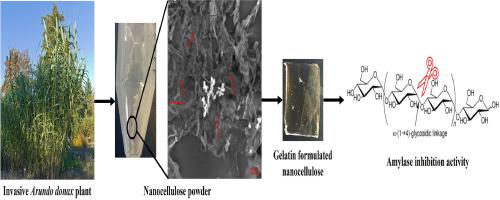明胶基弹道凝胶与植物合成纳米纤维素配制而成,具有抑制α-淀粉酶的活性
IF 6.2
Q1 CHEMISTRY, APPLIED
Carbohydrate Polymer Technologies and Applications
Pub Date : 2024-09-24
DOI:10.1016/j.carpta.2024.100575
引用次数: 0
摘要
唐蜡(Arundo donax)是地中海地区的一种本地植物,作为一种入侵植物,它影响了本地植被的生长,最终降低了土壤质量,并影响了世界多个地区的食物链。因此,本研究旨在通过有机溶胶分馏和漂白法从唐蜡叶提取物中获得纤维素,然后进行离心分馏,得到中等单分散(0.428 PDI)的纳米纤维素,粒径为 91.2 nm,Zeta 电位为 -35.5 mV,在水介质(水)中具有高稳定性。此外,还将制得的纳米纤维素配制成弹道明胶水凝胶,并通过α-淀粉酶抑制活性研究了其抗糖尿病效果。对水凝胶样品(明胶和纳米纤维素的不同体积比)进行的系统表征表明,明胶与纳米纤维素含量为 18:2 (v/v) 的样品在 152 °C 前具有热稳定性,在 45 °C 前,纳米纤维素可从水凝胶中释放三天。这项研究证实了利用入侵植物物种提取纳米纤维素用于医疗目的的可行性和潜力。此外,明胶配制的纳米纤维素在剂量为 80 µg/mL 时具有抑制α-淀粉酶的活性,有望成为一种潜在的革命性医疗软糖,用于持续降低血糖水平。本文章由计算机程序翻译,如有差异,请以英文原文为准。

Gelatin-based ballistic gel formulated with phytosynthesized nanocellulose from Arundo donax for alpha-amylase enzyme inhibition activity
Arundo donax, an indigenous plant in the Mediterranean region, has affected the growth of native vegetation as an invasive plant, ultimately reducing soil quality and affecting the food chain in several areas of the world. Thus, the present work aims to obtain cellulose from the A. donax leaf extract via organosolv fractionation and bleaching method, followed by centrifugal fractionation to yield nanocellulose of moderately monodispersed (0.428 PDI) 91.2 nm in size and a zeta potential of -35.5 mV of high stability in aqueous medium (water). In addition, the resultant nanocellulose was formulated in ballistic gelatin hydrogel, and their antidiabetic effect via alpha-amylase enzyme inhibition activity was also investigated. Systematic characterization of the hydrogel samples (different volume ratios of gelatin and nanocellulose) revealed that the sample with 18:2 (v/v) gelatin:nanocellulose content is thermally stable until 152 °C, releasing nanocellulose for three days from hydrogel until 45 °C. This study confirms the feasibility and potential of utilizing invasive plant species to extract nanocellulose for medical purposes. Furthermore, the gelatin-formulated nanocellulose, with its demonstrated alpha-amylase inhibition activity at a dosage of 80 µg/mL, holds the promise of being a potential revolutionary medical gummy for sustained reduction of blood glucose levels.
求助全文
通过发布文献求助,成功后即可免费获取论文全文。
去求助

 求助内容:
求助内容: 应助结果提醒方式:
应助结果提醒方式:


